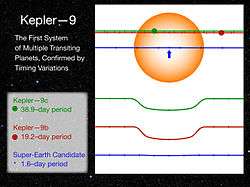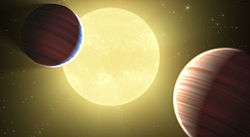Kepler-9
Kepler-9 is a sunlike star in the constellation Lyra. Its planetary system, discovered by the Kepler Mission in 2010 was the first detected with the transit method found to contain multiple planets.
| Observation data Epoch J2000 Equinox J2000 | |
|---|---|
| Constellation | Lyra[1] |
| Right ascension | 19h 2m 17.7544s[2] |
| Declination | +38° 24′ 03.177″[2] |
| Apparent magnitude (V) | 13.9[3] |
| Astrometry | |
| Proper motion (μ) | RA: 2.491±0.028[2] mas/yr Dec.: −14.713±0.032[2] mas/yr |
| Parallax (π) | 1.5629 ± 0.0170[2] mas |
| Distance | 2,090 ± 20 ly (640 ± 7 pc) |
| Characteristics | |
| Spectral type | G2V |
| Details[4] | |
| Mass | 1.022+0.029 −0.039 M☉ |
| Radius | 0.958±0.020 R☉ |
| Surface gravity (log g) | 4.49+0.02 −0.03 cgs |
| Temperature | 5774±60 K |
| Metallicity [Fe/H] | +0.05±0.07 dex |
| Rotation | 16.746±0.077 days[5] |
| Rotational velocity (v sin i) | 2.74±0.40[6] km/s |
| Age | 2.0+2.0 −1.3 Gyr |
| Other designations | |
| Database references | |
| SIMBAD | data |
| KIC | data |
Nomenclature and history
Kepler-9 was named for the Kepler Mission, a project headed by NASA that was designed to search for Earth-like planets.[8] Unlike stars such as Aldebaran or Sirius, Kepler-9 does not have a colloquial name.
In June 2010, some 43 days after Kepler came online, its operating scientists submitted a list of over 700 exoplanet candidates for review. Of those, five were originally suspected to have more than one planet. Kepler-9 was one of the multiplanetary systems; it was identified as such when scientists noticed significant variations in the time intervals at which Kepler-9 was transited.[9] Kepler-9 holds the first multiplanetary system discovered using the transit method. It is also the first planetary system where transiting planets were confirmed through transit timing variations method, allowing to calculate the masses of planets.[10] The discovery of the planets was announced on August 26, 2010.[9]
Characteristics
Kepler-9 is located in the constellation Lyra that lies some 620 parsecs away from Earth. With a mass of 1.07 M☉ and a radius of 1.02 R☉, Kepler-9 is almost exactly the same size and width of the Sun, being only 7% more massive and 2% wider. Kepler-9 has an effective temperature of 5777 (± 61) K, as compared to the Sun's at 5778 K,[11] and is approximately 32% more metal-rich (in terms of iron) than the Sun. Kepler-9 is younger than the Sun, and is estimated to be one billion years old.[12]
Planetary system

There are three confirmed planets, all in direct orbit. The outer two planets, Kepler-9b (the inner one) and Kepler-9c (the outer one), are low-density gas giants that are respectively 25% and 17% the mass of Jupiter and around 80% the radius of Jupiter. Both planets have a density less than that of water, similar to Saturn. The innermost planet, Kepler-9d, is a super-Earth with a radius that is 1.64 times that of Earth,[13][12] orbiting the star every 1.6 days. It is estimated that there is a 0.59% chance that the discoveries are false.[12]
From Kepler-9d (closest to star) to Kepler-9b (second from star), the ratio of their orbits is 1:12. However, the ratio of the orbits of the two outer planets is 1:2, a relationship known as a mean motion resonance. Kepler-9b and Kepler-9c are the first transiting planets detected in such an orbital configuration.[14] The resonance causes the orbital speeds of each planet to change, and thus causes the transit times of the two planets to oscillate. The period of Kepler-9b is increasing by 4 minutes per orbit, while that of Kepler-9c is decreasing by 39 minutes per orbit. These orbital changes allowed the masses of the planets (a parameter not normally obtainable via the transit method) to be estimated using a dynamical model. The mass estimates were further refined using radial velocity measurements obtained with the HIRES instrument of the Keck 1 telescope.[14][15]
Kepler-9b and 9c are thought to have formed beyond the "frost line". They are then thought to have migrated inward due to interactions with the remains of the protoplanetary disk. They would have been captured into orbital resonance during this migration.[14]
| Companion (in order from star) |
Mass | Semimajor axis (AU) |
Orbital period (days) |
Eccentricity | Inclination | Radius |
|---|---|---|---|---|---|---|
| d | — | 0.02730+0.00042 −0.00043 |
1.592851±0.000045 | 0 | — | 1.64+0.19 −0.14 R⊕ |
| b | 44.71±0.24 M⊕ | 0.14276088±0.00000014 | 19.247 | 0.06378±0.00040 | 88.936±0.030° | 8.252±0.094 R⊕ |
| c | 30.79±0.17 M⊕ | 0.22889876±0.00000053 | 38.944 | 0.067990±0.000068 | 89.180±0.015° | 8.077±0.092 R⊕ |
See also
- List of extrasolar planets
- Kepler Mission
References
- Roman, Nancy G. (1987). "Identification of a Constellation From a Position". Publications of the Astronomical Society of the Pacific. 99 (617): 695–699. Bibcode:1987PASP...99..695R. doi:10.1086/132034. Vizier query form
- Brown, A. G. A.; et al. (Gaia collaboration) (August 2018). "Gaia Data Release 2: Summary of the contents and survey properties". Astronomy & Astrophysics. 616. A1. arXiv:1804.09365. Bibcode:2018A&A...616A...1G. doi:10.1051/0004-6361/201833051. Gaia Data Release 2 catalog entry
- "Planet Kepler-9 b". The Extrasolar Planets Encyclopaedia. Retrieved 19 December 2017.
- Borsato, L.; et al. (2019). "HARPS-N radial velocities confirm the low densities of the Kepler-9 planets". Monthly Notices of the Royal Astronomical Society. 484 (3): 3233–3243. arXiv:1901.05471. Bibcode:2019MNRAS.484.3233B. doi:10.1093/mnras/stz181.
- McQuillan, A.; Mazeh, T.; Aigrain, S. (2013). "Stellar Rotation Periods of The Kepler objects of Interest: A Dearth of Close-In Planets Around Fast Rotators". The Astrophysical Journal Letters. 775 (1). L11. arXiv:1308.1845. Bibcode:2013ApJ...775L..11M. doi:10.1088/2041-8205/775/1/L11.
- Wang, Songhu; et al. (2018). "Stellar Spin–Orbit Alignment for Kepler-9, a Multi-transiting Planetary System with Two Outer Planets Near 2:1 Resonance". The Astronomical Journal. 155 (2). 70. arXiv:1712.06409. Bibcode:2018AJ....155...70W. doi:10.3847/1538-3881/aaa2fb.
- "Kepler-9". SIMBAD. Centre de données astronomiques de Strasbourg. Retrieved 2019-11-29.
- "Mission overview". Kepler and K2. NASA. Retrieved 2 December 2017.
- "NASA's Kepler Mission Discovers Two Planets Transiting Same Star" (Press release). Pasadena, California: Jet Propulsion Laboratory. 2010-08-26. Retrieved 2019-11-28.
- Nancy Atkinson (26 August 2010). "Kepler Discovers Multi-Planet System". Universe Today. Retrieved 13 January 2011.
- David Williams (1 September 2004). "Sun Fact Sheet". Goddard Space Flight Center. NASA. Retrieved 20 March 2011.
- Torres, Guillermo; et al. (2011). "Modeling Kepler Transit Light Curves as False Positives: Rejection of Blend Scenarios for Kepler-9, and Validation of Kepler-9 d, A Super-earth-size Planet in a Multiple System". The Astrophysical Journal. 727 (1). 24. arXiv:1008.4393. Bibcode:2011ApJ...727...24T. doi:10.1088/0004-637X/727/1/24.
- Freudenthal, J.; et al. (2018). "Kepler Object of Interest Network. II. Photodynamical modelling of Kepler-9 over 8 years of transit observations". Astronomy and Astrophysics. 618. A41. arXiv:1807.00007. Bibcode:2018A&A...618A..41F. doi:10.1051/0004-6361/201833436.
- Holman, M. J.; et al. (2010). "Kepler-9: A System of Multiple Planets Transiting a Sun-Like Star, Confirmed by Timing Variations" (PDF). Science. 330 (6000): 51–54. Bibcode:2010Sci...330...51H. doi:10.1126/science.1195778. PMID 20798283.
- Alexander, Amir (2010-08-27). "From the Ground and from Space, New Planetary Systems Unveiled". Planetary Society web site. The Planetary Society. Archived from the original on 2010-09-01. Retrieved 2010-08-27.
External links
- Keith Cooper (26 August 2010). "Kepler finds first double planet transiting system", Astronomy Now. Accessed 7 September 2010.
